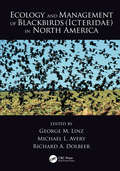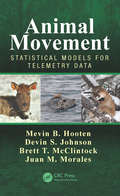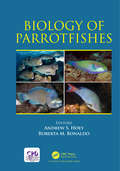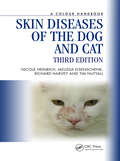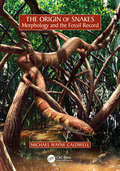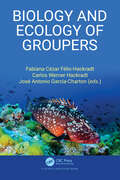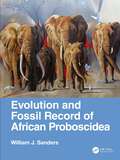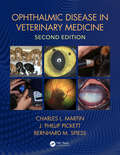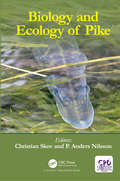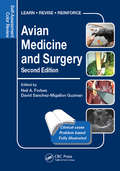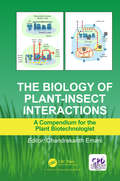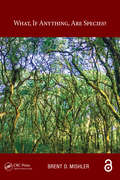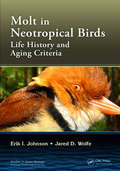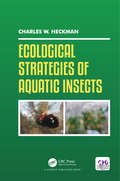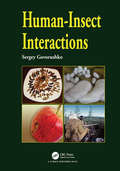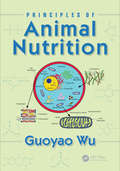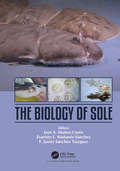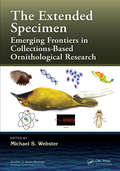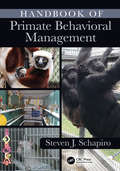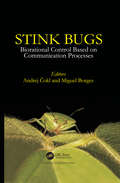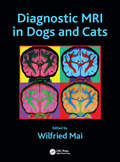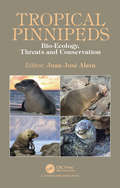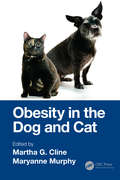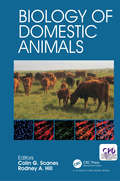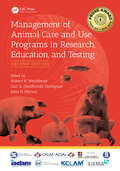- Table View
- List View
Ecology and Management of Blackbirds (Icteridae) in North America
by George M. Linz Michael L. Avery Richard A. DolbeerShortlisted for the 2018 TWS Wildlife Publication Awards in the edited book category The various species of new world blackbirds, often intermingled in large foraging flocks and nighttime roosts, collectively number in the hundreds of millions and are a dominant component of the natural and agricultural avifauna in North America today. Because of their abundance, conspicuous flocking behavior, and feeding habits, these species have often been in conflict with human endeavors. The pioneering publications on blackbirds were by F. E. L. Beal in 1900 and A. A. Allen in 1914. These seminal treatises laid the foundation for more than 1,000 descriptive and experimental studies on the life histories of blackbirds as well as their ecology and management in relation to agricultural damage and other conflicts such as caused by large winter roosting congregations. The wealth of information generated in over a century of research is found in disparate outlets that include government reports, conference proceedings, peer-reviewed journals, monographs, and books. For the first time, Ecology and Management of Blackbirds (Icteridae) in North America summarizes and synthesizes this vast body of information on the biology and life histories of blackbirds and their conflicts with humans into a single volume for researchers, wildlife managers, agriculturists, disease biologists, ornithologists, policy makers, and the public. The book reviews the life histories of red-winged blackbirds, yellow-headed blackbirds, common grackles, and brown-headed cowbirds. It provides in-depth coverage of the functional roles of blackbirds in natural and agricultural ecosystems. In doing so, this authoritative reference promotes the development of improved science-based, integrated management strategies to address conflicts when resolutions are needed.
Animal Movement: Statistical Models for Telemetry Data
by Mevin B. Hooten Devin S. Johnson Brett T. McClintock Juan M. MoralesThe study of animal movement has always been a key element in ecological science, because it is inherently linked to critical processes that scale from individuals to populations and communities to ecosystems. Rapid improvements in biotelemetry data collection and processing technology have given rise to a variety of statistical methods for characterizing animal movement. The book serves as a comprehensive reference for the types of statistical models used to study individual-based animal movement. Animal Movement is an essential reference for wildlife biologists, quantitative ecologists, and statisticians who seek a deeper understanding of modern animal movement models. A wide variety of modeling approaches are reconciled in the book using a consistent notation. Models are organized into groups based on how they treat the underlying spatio-temporal process of movement. Connections among approaches are highlighted to allow the reader to form a broader view of animal movement analysis and its associations with traditional spatial and temporal statistical modeling. After an initial overview examining the role that animal movement plays in ecology, a primer on spatial and temporal statistics provides a solid foundation for the remainder of the book. Each subsequent chapter outlines a fundamental type of statistical model utilized in the contemporary analysis of telemetry data for animal movement inference. Descriptions begin with basic traditional forms and sequentially build up to general classes of models in each category. Important background and technical details for each class of model are provided, including spatial point process models, discrete-time dynamic models, and continuous-time stochastic process models. The book also covers the essential elements for how to accommodate multiple sources of uncertainty, such as location error and latent behavior states. In addition to thorough descriptions of animal movement models, differences and connections are also emphasized to provide a broader perspective of approaches.
Biology of Parrotfishes
by Andrew S. Hoey Roberta M. BonaldoParrotfish are found on almost every coral reef in the world. This ubiquity and uniqueness of their feeding action make them one of the most important groups of fishes within coral reef ecosystems. But why, exactly, are parrotfish so important to reefs? Can the evolution of a particular jaw morphology and feeding action really have had such a large impact on the health and functioning of the world's coral reefs? This book introduces the reader to this fascinating group of fishes (Labridae, Scarinae), from the morphological innovation of a jaw that has the power to bite through solid calcium carbonate, to the threats currently faced by parrotfish populations around the world. It contains new insights into their diet and food processing ability, and lifehistories, and concludes with an overview of emerging and future research directions.
Skin Diseases of the Dog and Cat, Third Edition (Veterinary Color Handbook Series)
by Tim Nuttall Richard G. Harvey Nicole A. Heinrich Melissa EisenschenkKey features: • Completely updated in response to developments in veterinary dermatology over the last decade • Superb and generously sized colour photographs and diagrams • Describes lesion identification and diagnostic techniques in great detail, especially useful for revision • Chapters are organized based on symptoms, and each chapter has a decision tree: gives basic and practical guidance. • Clear user-friendly design with one condition per page (or spread of pages) • Referenced thoughout to give the clinician access to the literature A Colour Handbook of Skin Diseases of the Dog and Cat was one of the first books to bring key information about skin diseases to clinicians in an easy-to-use problem-oriented format. This fully revised and updated Third Edition responds to the huge growth in knowledge about skin conditions over the last decade, including the discovery of new conditions, the development of new approaches to management, and effective new treatment options. 13 chapters covering over 120 skin, claw and ear conditions classified by their principle presenting sign. Concise, systematically structured text covering definition, aetiology and pathogenesis, clinical features, differential diagnoses, diagnostic tests and management. Flow charts in each chapter to help clinicians get to the right diagnosis. Special focus on diseases affecting paediatric patients as well as chapters discussing paw, ear and nasal planum diseases. Explanation of new treatments for atopic dermatitis. Over 350 superb colour photographs and diagrams, mostly new for this this edition. A focus on clinical practice and the need to explain the disease to the owner. Up-to-date and fully referenced throughout. This practical book continues to provide an entirely comprehensive guide to the diagnosis and management of veterinary skin conditions, in a format that is easily accessible for busy clinicians.
The Origin of Snakes: Morphology and the Fossil Record
by Michael Wayne CaldwellThis book presents perspectives on the past and present state of the understanding of snake origins. It reviews and critiques data and ideas from paleontology and neontology (herpetology), as well as ideas from morphological and molecular phylogenetics. The author reviews the anatomy and morphology of extant snakes. Methods are also critiqued, including those empirical and theoretical methods employed to hypothesize ancestral ecologies for snakes. The modern debate on squamate phylogeny and snake ingroup phylogeny using molecules and morphology is examined critically to provide insights on origins and evolution. Key Features Important major evolutionary transformation in vertebrate evolution Continuing historical debate in vertebrate paleontology Of wide interest to a core audience of paleontologists, herpetologists, and morphologists Author acknowledged as prominent contributor to debate over snake origins Based on remarkable well preserved fossil specimens
Biology and Ecology of Groupers
by Fabiana Cézar Félix-HackradtGroupers are fascinating charismatic fishes commonly found in reef habitats around the world that sustain a global multimillionaire fishery. They are an important top predator species and therefore of paramount ecological importance for reef systems' resilience. The book, Biology and Ecology of Groupers is an up-to-date review of the main bio-ecological topics involving worldwide groupers species oriented to the academic community and managers. It covers aspects of classification and phylogenetic relationships, geographical distribution, and life history related characteristics (Section I), including the major threats of groupers populations, case studies of successful management and comments about the future of groupers in our changing world (Section II).
Evolution and Fossil Record of African Proboscidea
by William J. SandersThis book details the long, diverse, and complex phylogenetic history of elephants and their fossil relatives (the Proboscidea), whose origin is deeply embedded some 60 million years ago in Africa. Most of the major evolutionary events of proboscideans occurred in Africa, and these are examined in their geological, paleoecological, geographic, and faunal contexts. Updated information about feeding adaptations, taxonomy and systematics, genetics, and site occurrences is included and summarized in tables, figures, and charts. This is the first comprehensive review of African proboscideans and illustrates the need to more actively protect elephants and ensure their survival in modern ecosystems. Key Features: Provides a comprehensive systematic review of the African proboscidean fossil record Includes a summary of taxonomy, geochronology, biogeography and morphology Documents major faunal events including those associated with hominin origins Synthesizes new data from genomic, isotopic, and microware analyses Emphasizes the role of elephants in ecosystems and the importance of conservation
Ophthalmic Disease in Veterinary Medicine
by Charles L. Martin J. Phillip Pickett Bernhard M. SpiessFeaturing a new author team, this seminal book has been completely updated and significantly expanded. Following an outline of the basic elements of ophthalmic science relevant to study and practice, the authors provide a detailed description and discussion of each condition including etiology, clinical signs, diagnosis, prognosis, and therapy, as well as a section dedicated to presumed inherited eye disorders. The focus throughout remains on the clinical needs of the practitioner and the student. Beautifully illustrated in full color, the book is aimed at trainee and practicing veterinarians interested in all types of ophthalmic diseases and disorders. Although the focus is on small animals, there is additional material on the horse and the cow. For this edition, a diverse group of authors from many geographic regions of training and practice offer a breadth of clinical expertise.
Biology and Ecology of Pike
by Christian Skov P. Anders NilssonThis book sets out to bridge the order scales among pike researchers, populations, communities, management, and fisheries. It emphasizes the progress of pike research during the last two decades, during which the order-bridging approach emerged. This framework underpins the text and the message, to convey its importance to pike research and to fish research in general. In addition, a considerable part of the book is devoted to management implications and highlights aspects of human dimensions in recreational fisheries.
Avian Medicine and Surgery: Self-Assessment Color Review, Second Edition (Veterinary Self-Assessment Color Review Series)
by Neil A. Forbes David Sanchez-Migallon GuzmanThis completely revamped second edition of Avian Medicine and Surgery includes over 260 all-new colour illustrated cases, with questions and answers fully exploring a breadth of diseases and disorders. Avian patients are a routine part of the veterinary case load and are being seen by many clinicians across the world. This book provides a unique quick reference for clinicians and a useful self-test for students by offering comprehensive, clinically-oriented information that can be quickly accessed, easily understood and applied. With contributions from leading international authorities with diverse fields of expertise, the book covers a wide range of disciplines, organ systems and species. The cases are presented in a random order, just as they would appear in daily practice, challenging the reader to address real clinical situation and offering, where possible, a comprehensive solution.
The Biology of Plant-Insect Interactions: A Compendium for the Plant Biotechnologist
by Chandrakanth EmaniOverviews of biochemical, genetic, and molecular perspectives of plant-insect interactions with added emphasis on bioinformatic, genomic, and transcriptome analysis are comprehensively treated in this book. It presents the agro-ecological and evolutionary aspects of plant-insect interactions with an exclusive focus on the climate change effect on the resetting of plant-insect interactions. A valuable resource for biotechnologists, entomologists, agricultural scientists, and policymakers, the book includes theoretical aspects as a base toward real-world applications of holistic integrated pest management in agro-ecosystems.
What, if anything, are species? (Species and Systematics)
by Brent D. MishlerThis book is an extended argument for abandoning the species rank. Instead, the author proposes that the rank of "species" be replaced by a pluralistic and multi-level view. In such a view, all clades including the smallest identifiable one would be named and studied within a phylogenetic context. What are currently called "species" represent different sorts of things depending on the sort of organisms and processes being considered. This is already the case, but is not formally recognized by those scientists using the species rank in their work. Adopting a rankless taxonomy at all levels would enhance academic studies of evolution and ecology and yield practical benefits in areas of public concern such as conservation. The Open Access version of this book, available at http://www.taylorfrancis.com/books/e/9781498714549, has been made available under a Creative Commons Attribution-Non Commercial license. KEY FEATURES • Proposes the replacement of restrictive species concepts with a pluralistic view • Suggests abandoning the formal taxonomic rank of "species" • Considers zoological, botanical, and microbiological aspects of the species level • Deals with practical issues such as conservation, inventories, and field guides
Molt in Neotropical Birds: Life History and Aging Criteria (Studies in Avian Biology)
by Erik I. Johnson Jared D. WolfeMolt is an important avian life history event in which feathers are shed and replaced. The timing, duration, seasonality, extent and pattern of molt follows certain strategies and this book reviews and describes these strategies for nearly 190 species based on information gathered from a 30-year study of Central Amazonian birds. Most species accounts are illustrated with several color photos focusing on wing and tail feather molt, molt limits, and how to use these patterns to accurately age birds. Published in collaboration with and on behalf of the American Ornithological Society, this volume in the highly-regarded Studies in Avian Biology series is a rich source of life history information for ornithologists working on tropical birds.
Ecological Strategies of Aquatic Insects
by Charles W. HeckmanThis book recounts the habits of many interesting and unusual exceptions to the rule that insects are typically terrestrial forms of life. It examines the different ways that groups of species have developed modes of existence in or on the surface of water, and gives reasons why the gross morphology of insects is not favorable for life in or near bodies of water, such as wings that fail to function after coming into contact with water, rendering them useless.
Human-Insect Interactions
by Sergey GovorushkoThis book presents a 360-degree picture of the world of insects and explores how their existence affects our lives: the "good, bad, and ugly" aspects of their interactions with humankind. It provides a lucid introductory text for beginning undergraduate students in the life sciences, particularly those pursuing beginner courses in entomology, agriculture, and botany.
Principles of Animal Nutrition
by Guoyao WuAnimals are biological transformers of dietary matter and energy to produce high-quality foods and wools for human consumption and use. Mammals, birds, fish, and shrimp require nutrients to survive, grow, develop, and reproduce. As an interesting, dynamic, and challenging discipline in biological sciences, animal nutrition spans an immense range from chemistry, biochemistry, anatomy and physiology to reproduction, immunology, pathology, and cell biology. Thus, nutrition is a foundational subject in livestock, poultry and fish production, as well as the rearing and health of companion animals. This book entitled Principles of Animal Nutrition consists of 13 chapters. Recent advances in biochemistry, physiology and anatomy provide the foundation to understand how nutrients are utilized by ruminants and non-ruminants. The text begins with an overview of the physiological and biochemical bases of animal nutrition, followed by a detailed description of chemical properties of carbohydrates, lipids, protein, and amino acids. It advances to the coverage of the digestion, absorption, transport, and metabolism of macronutrients, energy, vitamins, and minerals in animals. To integrate the basic knowledge of nutrition with practical animal feeding, the book continues with discussion on nutritional requirements of animals for maintenance and production, as well as the regulation of food intake by animals. Finally, the book closes with feed additives, including those used to enhance animal growth and survival, improve feed efficiency for protein production, and replace feed antibiotics. While the classical and modern concepts of animal nutrition are emphasized throughout the book, every effort has been made to include the most recent progress in this ever-expanding field, so that readers in various biological disciplines can integrate biochemistry and physiology with nutrition, health, and disease in mammals, birds, and other animal species (e.g., fish and shrimp). All chapters clearly provide the essential literature related to the principles of animal nutrition, which should be useful for academic researchers, practitioners, beginners, and government policy makers. This book is an excellent reference for professionals and a comprehensive textbook for senior undergraduate and graduate students in animal science, biochemistry, biomedicine, biology, food science, nutrition, veterinary medicine, and related fields.
The Biology of Sole
by Jose A. Muñoz-Cueto F. Javier Sánchez-Vázquez F. Javier Sanchez Vazquez Evaristo Mañanós-SánchezThis book reviews up-to-date knowledge on the biology of sole (Solea senegalensis and S. solea). These flatfish species are increasingly important in Europe both from the ecological and production point of view. This book is divided into two sections: A. general fisheries, aquaculture and engineering overviews; B. physiological, developmental, rhythmic, welfare and genetic aspects which will be of immense interest for the aquaculture industry. Experts, from both academia and research institutes, provide their expertise on sole biology.
The Extended Specimen: Emerging Frontiers in Collections-Based Ornithological Research (Studies in Avian Biology)
by Michael S. WebsterThe Extended Specimen highlights the research potential for ornithological specimens, and is meant to encourage ornithologists poised to initiate a renaissance in collections-based ornithological research. Contributors illustrate how collections and specimens are used in novel ways by adopting emerging new technologies and analytical techniques. Case studies use museum specimens and emerging and non-traditional types of specimens, which are developing new methods for making biological collections more accessible and "usable" for ornithological researchers. Published in collaboration with and on behalf of The American Ornithological Society, this volume in the highly-regarded Studies in Avian Biology series documents the power of ornithological collections to address key research questions of global importance.
Handbook of Primate Behavioral Management
by Steven J. SchapiroKey features: Offers chapters by renowned experts which are comprised of three subunits: a theoretical discussion of the content area, a description of the methods employed to address the content area, and finally, and most importantly, a discussion of the ways that relevant aspects of the content area can be easily employed/adapted to enhance the behavioral management of NHPs Provides case studies that highlight the areas of expertise of the authors and emphasize ‘success stories’ that can be used to develop behavioral management strategies and build behavioral management programs Presents ‘Genera-specific’ chapters which focus on behavioral management strategies that, typically, are successfully employed with particular taxa of NHPs Includes a novel, pioneering ‘Product/services’ section that provides the producers of important technologies, equipment, and services with an opportunity to highlight the ways in which their products enhance the ability of their clients to manage the behavior of NHPs Illustrated with full color images and drawings throughout. The Handbook of Primate Behavioral Management (HPBM) fills a void in the scientific literature, providing those who work with nonhuman primates (NHPs) with a centralized reference for many issues related to the care and behavioral management of captive nonhuman primates. While there are numerous publications scattered throughout the literature that deal with the behavioral management of NHPs, this comprehensive handbook is the first single-source reference to summarize and synthesize this information. The HPBM is organized into six complementary parts starting with an introductory section. The book then provides in-depth coverage of content issues, applications and implementation, genera-specific chapters, technology-related questions involved in the behavioral management of NHPs, and a concluding section. Primate behavioral management is a topic that has recently generated a considerable number of primary publications in the scientific literature, mostly with an applied focus. Similarly, there are many primary publications currently available that address more basic issues related to the understanding of primate behavior. One of the principal goals of the HPBM is to highlight and synthesize basic science advances that can be adapted and applied to enhance the behavioral management of captive NHPs.
Stinkbugs: Biorational Control Based on Communication Processes
by Andrej Čokl Miguel BorgesThis book presents an overview of the Pentatomidae species, covering their biology, phylogeny and reproductive behavior, main plants used in their diet and their nutritional exigencies, predatory stinkbugs, interactions between herbivores-plants and natural enemies, use of pheromone for monitoring phytophagous populations, and chemical and vibrational communication signals. It also presents possible technologies to be applied in field crops for pest management that could be developed as the basis of the interplay of stink bug communication signals.
Diagnostic MRI in Dogs and Cats
by Wilfried MaiKey features The first reference textbook to provide a well-illustrated and comprehensive overview of the current knowledge in MRI in small animal veterinary practice Includes both evidenced-based material and the authors' personal experience, providing an excellent overview of current knowledge in the field. Contributors are international leaders in the field. Contains over 650 images of the highest quality. Bullet points format and table summaries throughout the book keep the concepts concise and organized. All the information presented reflects knowledge that is supported by peer-reviewed scientific publications, referenced at the end of each chapter – it is a book of ‘facts’. Richly illustrated with over 650 annotated images showcasing the main features of the disease processes. Images are obtained at all magnet field strengths, so as to reflect the current reality of veterinary MRI, which uses low-, mid- and high-field magnets. Diagnostic MRI in Dogs and Cats makes the vast and increasingly complex topic of clinical MRI in small animals accessible to all veterinarians. With the increasing availability of MRI technology, there is also a pressing need for expertise in interpreting these images. This is the first reference textbook to provide a well-illustrated and comprehensive overview of the current knowledge, focusing on imaging appearance rather than on clinical signs or treatment. With chapters on MRI physics and technology as well as sections on specific anatomical regions, the book functions as a stand-alone reference for the reader, whether they be a radiology/neurology resident in training or a practitioner with a need to learn about veterinary clinical MRI. Each chapter is authored by internationally-renowned experts in the specific area of veterinary radiology, disseminating their experience and summarizing the current knowledge to provide an excellent overview of what is currently known in the field. The chapters on physics and MRI technology are concise and accessible, using many visual aids and diagrams, and avoiding abstract concepts and equations whenever possible. Within each anatomical section, each chapter focuses on a disease category of that body region. When it is important to understand the imaging appearance, the pathophysiology is reviewed and imaging features of prognostic relevance are detailed. This practical yet thoroughly comprehensive book is primarily an evidence-based learning resource for trainees, but will also aid practising veterinarians who have less MRI experience.
Tropical Pinnipeds: Bio-Ecology, Threats and Conservation
by Juan José AlavaPinnipeds are a fascinating group of marine mammals that play a crucial role as apex predators and sentinels of the functioning and health of marine ecosystems. They are found in the most extreme environments from the Polar regions to the tropics. Pinnipeds are comprised of about 34 species, and of those at least 25% live permanently in tropical zones. This book reviews and updates current research on the biology, marine ecology, bio-monitoring, and conservation of tropical pinniped populations, including their behavior, anthropogenic stressors, and health. It also looks at challenges to be faced for the conservation of tropical pinnipeds, many of which are threatened species.
Obesity in the Dog and Cat
by Martha G. Cline Maryanne MurphyThis is an indispensable guide for any veterinarian or veterinary technician interested in better understanding the disease of obesity. The authors reach far beyond the traditional clinical approach of, "Feed less, exercise more," and explore the current pathophysiology of obesity and emerging treatment options. Thoroughly researched and packed with practical advice, this is the textbook I wish I had twenty-five years ago. Highly recommended. - Ernie Ward, DVM, CVFT, Founder, The Association for Pet Obesity Prevention This book will be valuable for anyone managing obesity cases in practice as there is considerable practical information. I found the chapter on behavioral management of obesity especially useful. There is also good information on the pathophysiology and sequaela of obesity. By necessity, there is information from human obesity where we don't have sufficient information in dogs and cats; however, this points to useful areas for future research. - Marge Chandler, DVM, MS, MANZCVS, DACVN, DACVIM-CA, MRCVS, Clinical Nutritionist at Vets Now Referrals, Co-Chair of the WSAVA Global Nutrition Committee, and Chair of the FEDIAF Scientific Advisory Board Key features: Reviews epidemiology and how animal- and human-specific factors contribute to excess weight gain. Discusses the metabolic effects and inflammatory mediators associated with adiposity. Looks at various disease states and how they relate or develop as a result of obesity. Reviews different modalities to determine body composition to diagnose obesity. Offers a clinical approach to managing obesity with diet including discussion on the nutrients of concern for therapeutic weight loss diets. As of 2018, pet obesity in the US affects an estimated 55.8 percent of dogs and 59.5 percent of cats, resulting in secondary conditions such as arthritis, diabetes mellitus, kidney disease, and certain forms of cancer. A complete and balanced diet accompanied by regular exercise is fundamental to optimize health and longevity in companion animals, meaning overweight pets have reduced quality of life and shorter life expectancy. Seeking to address this major modern-day problem, this book provides a comprehensive review of obesity in small animal medicine. Veterinarians seeking to provide weight management services in practice will find clinically-applicable information from expert authors from both academic and practice backgrounds. Chapters cover topics ranging from epidemiology and pathophysiology of obesity to evaluation of body composition, and nutritional and behavioral management. The book also explores the role of exercise in managing obesity and looks at the management of co-morbidities. Finally, the authors present a range of case studies to demonstrate these topics in real-life practice.
Biology of Domestic Animals
by Colin G. Scanes Rodney A. HillThere is increasing interest in the biology of domestic animals ranging from genomics, transcriptomics, metabolomics, nutritional physiology, and systems biology. This book touches on all of these, with a particular focus on topics such as domestic animals as comparative models to humans, molecular regulation of growth, metabolic efficiency, reproduction, and the impact of stress on growth and development. The book concludes with a discussion on the current and future directions for researchers.
Management of Animal Care and Use Programs in Research, Education, and Testing
by Robert H. Weichbrod Gail A. Heidbrink Thompson John N. NortonAAP Prose Award Finalist 2018/19 Key features - Offers a revised, updated, and comprehensive first-line management book for those working in animal care and use programs who have the responsibility to ensure the welfare of the animals in the highest quality research environment - Serves as an indispensable resource text for certification exams and credentialing boards for a multitude of professional societies - Emphasizes the importance of developing a collaborative culture of care within an animal care and use program and provides information about how behavioral management through animal training can play an integral role in a veterinary health program - Provides a new section on Environment and Housing, containing chapters that focus on management considerations of housing and enrichment delineated by species - Expands coverage of regulatory oversight and compliance, assessment, and assurance issues and processes, including a greater discussion of globalization and harmonizing cultural and regulatory issues - Includes more in-depth treatment throughout the book of critical topics in program management, physical plant, animal health, and husbandry Biomedical research using animals requires administrators and managers who are knowledgeable and highly skilled. They must adapt to the complexity of rapidly-changing technologies, balance research goals with a thorough understanding of regulatory requirements and guidelines, and know how to work with a multi-generational, multi-cultural workforce. Management of Animal Care and Use Programs in Research, Education, and Testing, Second Edition is the extensively expanded revision of the popular Management of Laboratory Animal Care and Use Programs book published earlier this century. Following in the footsteps of the first edition, this revision serves as a first line management resource, providing for strong advocacy for advancing quality animal welfare and science worldwide, and continues as a valuable seminal reference for those engaged in all types of programs involving animal care and use. It has more than doubled the number of chapters in the original volume to present a more comprehensive overview of the current breadth and depth of the field with applicability to an international audience. Readers are provided with the latest information and resource and reference material from authors who are noted experts in their field. Co-publishers on the second edition are: ACLAM (American College of Laboratory Animal Medicine); ECLAM (European College of Laboratory Animal Medicine); IACLAM (International Colleges of Laboratory Animal Medicine); JCLAM (Japanese College of Laboratory Animal Medicine); KCLAM (Korean College of Laboratory Animal Medicine); CALAS (Canadian Association of Laboratory Animal Medicine); LAMA (Laboratory Animal Management Association); and IAT (Institute of Animal Technology).
